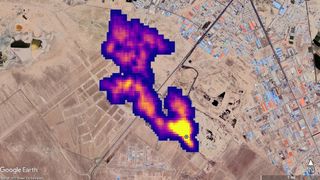A NASA science instrument in orbit will form the foundation of a brand-new effort to study methane emissions from garbage dumps in a brand-new not-for-profit job to track the greenhouse gas. The brand-new job, led by the not-for-profit group Carbon Mapper, will utilize information gathered from the International Space Station by NASA's EMIT experiment(its name is brief for Earth Surface Mineral Dust Source Investigation) and other NASA science instruments to track methane, which according to NASA is the source of around a quarter to a 3rd of human-driven worldwide warming. By developing a standard evaluation of waste websites throughout the world, and identifying which websites give off methane at high rates, the effort might assist decision-makers lower the concentration of the greenhouse gas in the environment therefore restricting environment modification Related: 10 indications of environment modification satellites see from area " Currently, there is minimal actionable info about methane emissions from the worldwide waste sector," Carbon Mapper CEO Riley Duren stated in a NASA declaration "An extensive understanding of high-emission point sources from waste websites is a vital action to alleviating them." In contrast to co2, methane is pound for pound 80 times more powerful in trapping heat in the environment. Unlike co2, nevertheless, methane does not last as long in Earth's environment and has a life time of years instead of centuries. This suggests that substantially lowering methane emissions might have an instant impact in slowing climatic warming. As the waste sector is approximated to contribute around 20% of human-caused methane emissions it is among the main focuses of the objective to decrease this greenhouse gas. " New technological abilities that are making these emissions noticeable-- and for that reason actionable-- have the prospective to alter the video game, raising our cumulative understanding of near-term chances in this frequently neglected sector," Duren stated. The Carbon Mapper job will carry out a preliminary remote-sensing study of over 1,000 handled land fills throughout the United States, Canada, and other websites in Latin America, Africa, and Asia in 2023. This information will be gathered utilizing aircraft-based sensing units such as the Airborne Visible/Infrared Imaging Spectrometer-Next Generation ( AVIRIS-NG(opens in brand-new tab)) and Arizona State University's Global Airborne Observatory both established at NASA's Jet Propulsion Laboratory(JPL) in Southern California. The task will likewise utilize methane information from EMIT which was set up at the International Space Station in July with the function of the studying the mineral material of the world's significant dust-producing areas. In October 2022, EMIT showed its ability in methane detection, identifying methane plumes from over 50 so-called "super-emitters" in Central Asia, the Middle East and the Southwestern United States. " NASA JPL has a decade-long performance history of utilizing air-borne imaging spectrometers to make top quality observations of methane point-source emissions," Robert Green, the EMIT principal detective at JPL, stated in the NASA declaration. "With EMIT we have actually utilized the very same innovation in a spaceborne instrument, allowing us to gather info on localized methane sources from orbit." Following its very first year, the Carbon Mapper group will start a wider study of around 10,000 garbage dump websites around the world utilizing satellites geared up with imaging spectrometer innovation established at JPL. These specifically purposed Carbon Mapper spacecraft are set to release in late2023 Follow us on Twitter @Spacedotcom or on Facebook Join our Space Forums to keep talking area on the most recent objectives, night sky and more! And if you have a news suggestion, correction or remark, let us understand at: community@space.com.

Read More
https://futurenewsforyou.com/news/nasa-sensors-could-help-detect-landfill-methane-from-space-to-help-limit-climate-change/?feed_id=140&_unique_id=63b2aa48113eb
luni, 2 ianuarie 2023
NASA sensors could help detect landfill methane from space to help limit climate change
Etichete:
News,
Newsomatic_0_0
Abonați-vă la:
Postare comentarii (Atom)
Niciun comentariu:
Trimiteți un comentariu